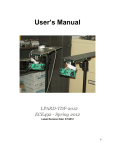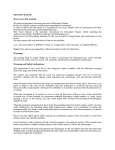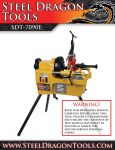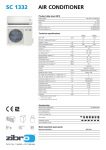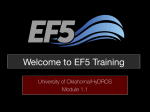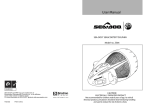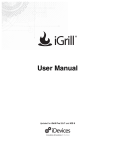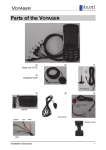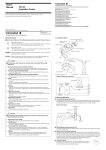Download LPARD-BSRD Draft: Suggested Emotion Edge
Transcript
LPARD-BSRD Draft: Suggested Emotion Edge Kayak Parameters: a = boat major axis in meters, b = boat minor axis in meters, c = boat height minor axis in meters, boat is assumed to be an ellipse m = boat mass in kg r = density of water in kg/m3 Tr = time for a full revolution in seconds wmax = max rotational velocity m = dynamic viscosity of water at room temp Vrotmax = Maximum rotational velocity at 1/4 length from boat center a = 1.448 b = 0.3668 c= 1 3 *b m = 34 r = 998.2 Tr = 20 wmax = 2 p 20 m = 1 * 10-3 Vrotmax = wmax * 0.25 * a Vmax = 2 Motors: -The boat model predicted a combined force of 42N for the forward motors to reach top speed. -Vmax must meet 2 m/s velocity max based on hull velocity analysis -Approximation estimates about 200W of power given to each motor. -For the sideways motors we estimate 100W of force each -Based on preliminary research the inlet diameter will be approximately 0.1312 feet. Manual Control: -75 MHz 3-6 Channel RF Link -RC controller is the only mechanism capable of switching to manual mode -Restores to Freeze Mode on release Use Cases: Two possible ways of taking depth measurements: The first is by using a pressure transducer - by lowering this device down into the water the amount of pressure above the device would determine the depth. Option two was to use on-board sonar on the hull of the boat. Determining pH levels through taking measurements about 6 inches below the surface(Note on shallow waters around Lafayette College: the Bushkill creek is about a little less than a foot deep in the shallow areas up to around 8 feet in the deepest areas). Turbidity may require optical measuring devices and can be used for a variety of other measurements, such as salinity (Note on basic principle of measuring: take a measurement of conductivity and translate that into specific measurement desired). For measuring dissolved gases, hydrologists might care about the amount of dissolved oxygen in the water, though different end users may want to see other dissolved gases. (Reference: Megan Rothenberger of the Biology department who works in the area of water quality) Packaged measurements that do multiple tests (temp, pH, depth), but these packages are very costly. **For legal issues, there shouldn't be any problems since the vehicle is unmanned; many issues arise when there people aboard a watercraft. LPARD-TDF-2012 On Water Safety Plan: The purpose of this safety plan is to present information and rules that will help in the prevention of injury or serious harm while using the LPARD-TDF-2012 system. This safety plan is not all inclusive, but is meant to inform the user so as to prevent the vast majority of injuries. The system designers and manufacturers are by no means responsible for any injuries that occur during the use of the LPARD-TDF-2012 system if the items within the this safety plan and supplemental User’s Manual are not abided by. Safety Procedures Electrical: 1. Keep electrical equipment (laptop, shore power supply, shore sensors, etc. at least 20 feet away from any water source to avoid possible electrocution and equipment damage. 1. If electrical components smell like they are burning, power down the system as soon as possible and do not touch any electrical components because they might be extremely hot and cause burns. 1. Malfunctioning electrical components run the risk of catching on fire. If the boat or any subsystem catches on fire, do not throw water on any system that is powered up. Proceed with caution when putting out electrical fires and avoid contact with flame. 1. Powering up: If the boat is being powered in maintenance mode, keep the power cord and electrical output free of any possible water sources that could cause electrical shock. 1. Check electric components often for visible problems and have spare fuses ready at all times. Environmental: 1. While the LPARD-TDF-2012 system is designed to operate in suboptimal conditions, it is recommended that the system is not used when in poor weather conditions. Check wheather forecasts before planning and trip and consistently keep an eye on the sky to make sure that there are no developing clouds or storms. Lighting storms and extremely windy conditions can cause suboptimal conditions that could result of serious injury. 1. Shore equipment should be setup and operated on a relatively flat surface so that the equipment as well as the user are able to operate on stable ground. 1. Be sure to survey the shore station setup area and do not set up the shore station in an area that at risk of falling rocks or tree limbs. 1. If you must step into the water to position or pick up the boat, make sure that there are not submerged objects that can possible cause physical harm. 1. Take precautions to limit the amount of UV exposure due to the sun. It is recommended to wear sunscreen if planning on operating the system for a prolonged period of time. Attire: 1. Proper footwear should be used when setting up and operating the LPARDTDF-2012 system. The shores of rivers, creeks and streams are uneven and often difficult to navigate. Inappropriate footwear will greatly increase the risk of slipping or falling. Mechanical: 1. At no point should hands or fingers be placed near the propulsion components when the system is powered on. If the propulsion system gets dirty or jammed, be sure to power the system down before attempting to clean or handle the boat. 1. Malfunctions are always possible. If the propulsion system goes down while the boat is on the water, try to avoid getting in the water to retrieve it. It this is absolutely necessary to enter the water, wear a flotation device. 1. Do not operate the boat in manual or autonomous mode in a location where there is a chance of hitting other boats or swimmers. Survey the area both upstream and downstream to make sure that no one has a possibility of getting hit. 1. Do not steer the boat towards protruding rocks or trees in the water. If the objects are visible, use manual mode to ensure that the boat does not accidentally hit an object and cause damage. 1. Do not attach external objects to the boat that the boat is not specifically meant to carry that can add extra weight or cause the boat to become overloaded or unbalanced. Transportation: 1. While transporting the LPARD-TDF-2012 system, make sure that the boat and all other required equipment are properly fastened to the vehicle. Do not use straps or cables that are partially torn or show excessive wear. 1. Use an appropriate vehicle to transport the entire system. Do not position any system parts in the vehicle that will obstruct the driver’s view. Other: 1. While the system is designed to have the ability to be operated by a single person, it is recommended to not work alone in isolated areas. Someone should be kept within earshot at all times since cell phone carriers’ are not available at all locations. 1. Even though it is not entirely necessary, it is recommended that a lifeguard/EMT certified individual present in case of an emergency. 1. Do not launch the boat from a dock or launch ramp while other boats are trying to dock / cast off. 1. If planning on operating the system at nighttime, have a flashlight ready so that it is possible to navigate obstacles on the shore safely. 1. Depending on the location of operation, always be aware of dangerous wildlife that may be present.




